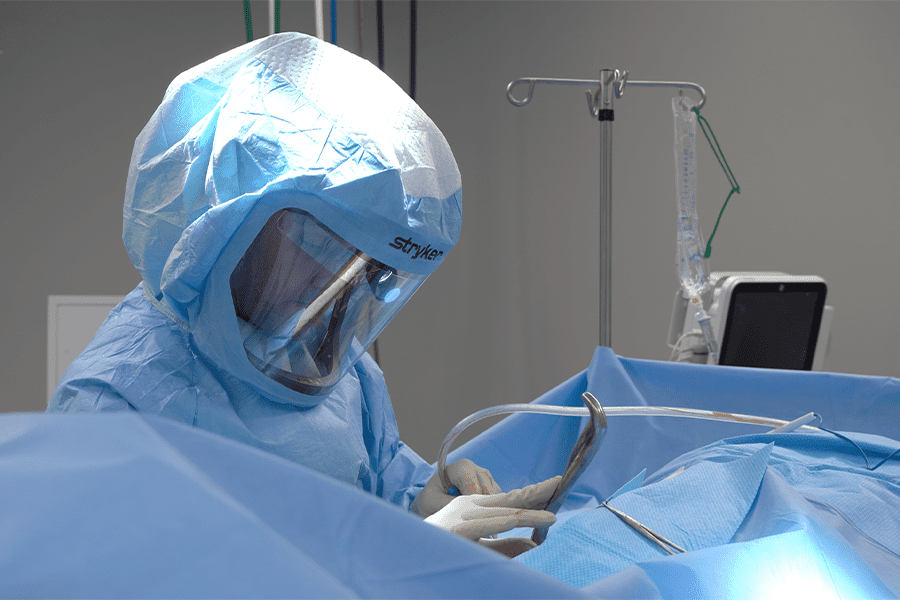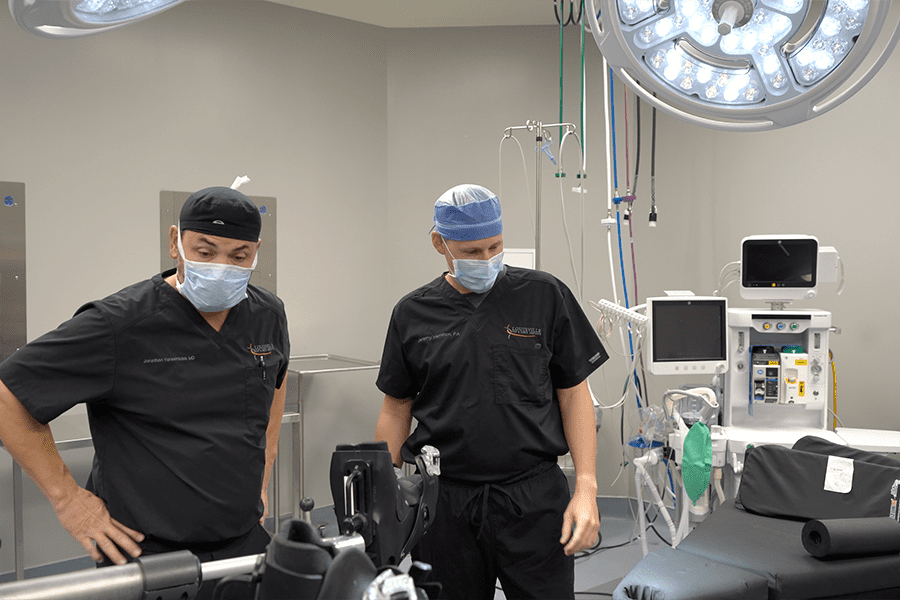- What happens during a hip replacement?
- What are the stages of recovery after a hip replacement?
- Is hip replacement right for you?
Total joint replacement surgeries are some of the most commonly performed elective surgeries in the United States. Often used to treat late-stage arthritis, these procedures remove and replace damaged joints to relieve pain and improve mobility.
Total joint replacement surgeries are some of the most commonly performed elective surgeries in the United States. Often used to treat late-stage arthritis, these procedures remove and replace damaged joints to relieve pain and improve mobility.
One of the most frequently performed joint replacement surgeries is a total hip replacement. Approximately 400,000 of these procedures are performed each year in the United States, with projections showing an expected 179% increase by 2030.
These numbers make sense—as surgical methods improve and recovery times decrease, the procedure has become increasingly accessible and offers high success rates for patients who struggle with pain and mobility issues.
Jonathan G. Yerasimides, M.D., board-certified orthopedic surgeon at the Louisville Hip & Knee Institute says, “patients ask me how long it takes to recover from a hip replacement. Every patient is a little bit different but having done over 10,000 of these procedures at this point in my career, I’ve got a pretty good idea.”
In this article, Dr. Yerasimides explains the recovery process for hip replacement surgery and what patients can expect from their procedure.
What happens during a hip replacement?

During hip replacement surgery, a surgeon will carefully remove the worn-out hip joint and replace it with a human-made prosthetic. Modeled after the original joint, the prosthetic is made of durable materials, including ceramic, metal, or plastic,and can last up to 25 years.
As an invasive surgery, doctors often reserve hip replacement surgery for when more conservative treatments fail to provide relief. For many patients, the procedure offers an alternative that resolves their worst symptoms by removing the source of their discomfort.
In these cases, their pain is often so severe that it can no longer be relieved by medications. Among patients who choose to undergo the procedure, many experienced pain-related symptoms such as:
- Disrupted sleep
- Difficulty walking or standing
- Discomfort in a resting position
- An inability to participate in social activities
For these patients, the decision to undergo surgery is simple—without it, their quality of life would continue to diminish, limiting them from the activities they enjoy.
Once the new joint is in place, many patients experience immediate relief of their symptoms and gradually regain mobility in their hip as they recover.
What are the stages of recovery after a hip replacement?
While everyone heals at their own pace, patients can expect the complete recovery process to take between two to three months. However, in many cases, patients will regain partial mobility within as little as a day or two of their procedure.
Dr. Yerasimides says, “For complete recovery, where you’re waking up every day, and putting on your pants and socks and shoes, without remembering that anything is even there, is usually around the three-month window.”
What happens during those first 90 days after hip surgery? Typically, we see:
Day 1
- Most patients can walk on the same day of their surgery with the aid of a walker
- Patients will require someone to drive them home and assist with after-care instructions
- Doctors recommend wearing compression socks, which help prevent blood clots
- Pain medication as needed
First week
- Daily physical therapy exercises and wound care
- Pain medications to manage discomfort
- Assistance will still be required with chores
- Limited physical activity to improve circulation
- Sponge baths to clean and protect incisions
Two weeks
- Check in with the doctor to monitor your health and have your sutures removed
- Gradually increase physical activity with at-home strengthening exercises or a physical therapist
- Patients can now take showers
- Walking without the assistance of a cane or mobility device
Three to six weeks
- Slowly resume light activities around the home under your doctor’s supervision
- Weekly check-ups with your doctor
- Strengthening and balance exercises
Week Six
- Patients can begin driving again (with the doctor’s approval)
- Increased autonomy at home (dressing, chores, cooking)
Weeks 10-12
- Resume normal exercises
- Patients will be able to walk longer distances
- Resume low-impact activities like gardening or dog-walking
Three Months+
- Restored mobility and hip function
- Continued check-ins with your doctor for the first year
These milestones reflect the recovery process for most patients. However, because everyone heals differently, more or less time may be required to heal. Speak with your doctor to learn more about what you can expect from the recovery process.
What Is Anterior Hip Replacement Surgery?

Not all hip replacement surgeries are the same. Dr. Yerasimides practices the least invasive form of this surgery known asanterior hip replacement, which seeks to minimize the impact on the surrounding tissue as the joint is removed and replaced.
Compared to traditional hip replacement surgery, which requires broader cuts that can damage the surrounding tissue, anterior hip replacement offers significant benefits:
- Less pain
- Shorter recovery
- Decreased chance of hip dislocation post-surgery
- Less trauma to critical muscle and ligament groups
- Smaller incisions and less blood loss
- Higher accuracy in leg lengths
While anterior hip replacement can improve how quickly you heal, the true key to a speedy recovery is following your doctor’s instructions.
Depending on your doctor’s recommendations, follow their recovery protocol carefully, using a cane, crutches, or a walker throughout the initial stages of your healing process.
On top of physical therapy exercises, your doctor may also recommend a stationary bicycle to keep your hip flexible and increase circulation. The good news is that most patients recover well from these surgeries with few complications to slow down their progress.
Is Hip Replacement Right for You?
Don’t let hip pain prevent you from doing what you love. If you’re suffering from a lack of mobility or severe pain, Dr. Yerasimides and the talented team at Louisville Hip & Knee Institute are here to help you make a full recovery.
Call us today at 502-HIP-KNEE.
 Doctors often recommend hip replacement surgery for patients suffering from pain that diminishes their quality of life.
Doctors often recommend hip replacement surgery for patients suffering from pain that diminishes their quality of life.
In most cases, patients try other treatment options, such as medications, steroid injections, and physical therapy. However, at some point, the pain, stiffness, and mobility issues return and treatments stop working. When this occurs, hip replacement surgery is often the best most effective solution.
Like any major surgery, the surgery is only available for patients who are in relatively good health and who are fit to undergo anesthesia. Conditions that increase the risk of complications during major surgery, such as uncontrolled diabetes or active infections, may exclude some individuals from undergoing the procedure.
Struggling with hip pain?
Dr. Greene and the team at Louisville Hip and Knee have performed more than 12,000 anterior hip replacement procedures in the past 15 years. Like Bob, these patients have regained their mobility and live free from the pain that held them back from doing what they loved.
Speak with one of our experienced team members by calling 502-HIP-KNEE (447-5633) to learn if hip replacement surgery is right for you.

